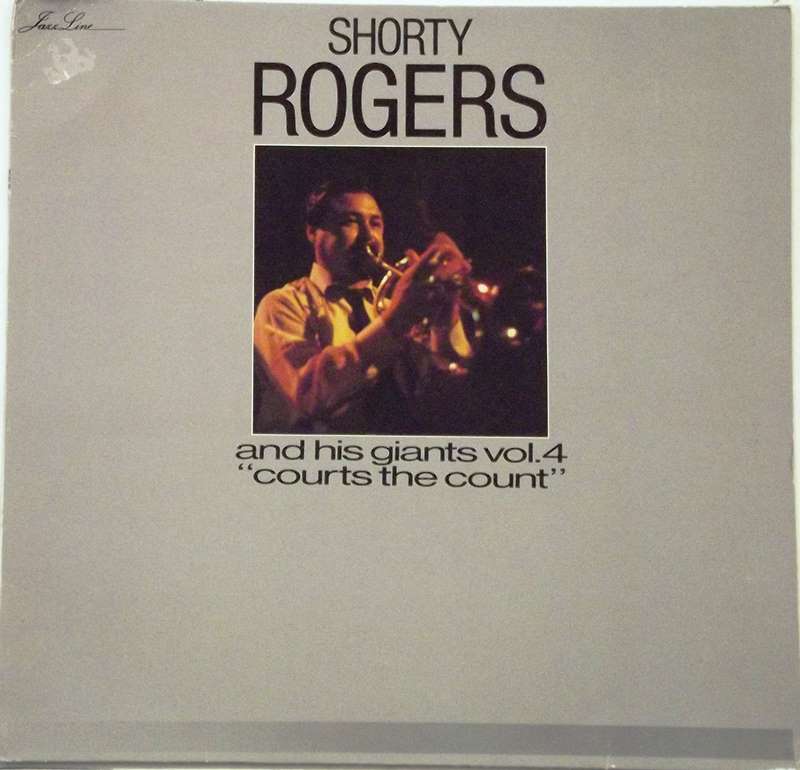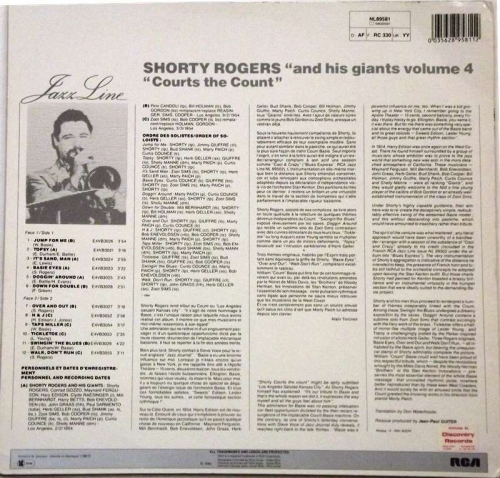

| Product Code: | NL89581 |
| Artist: | Shorty Rogers And His Giants |
| Origin: | Germany |
| Label: | RCA (1986) |
| Format: | LP |
| Availability: | In Stock |
| Condition: |
Cover: VG+
Record: NM (M-)
|
| Genre: | Jazz U |
Very rare German pressed album with a smart gloss cover.
Rogers worked first as a professional musician with Will Bradley and Red Norvo. From 1947 to 1949, he worked extensively with Woody Herman and in 1950 and 1951 he played with Stan Kenton.[1]
Rogers appeared on the 1954 Shelly Manne album The Three and the Two along with Jimmy Giuffre. Much of the music he recorded with Giuffre showed his experimental side, resulting in an early form of avant-garde jazz. He also made notable recordings with Art Pepper and André Previn, among others.
From 1953 through 1962 Rogers recorded a series of albums for RCA Victor (later reissued on RCA's Bluebird label), as well as a series of Atlantic albums with his own group, Shorty Rogers and His Giants, including Shorty Courts the Count (1954), The Swinging Mr. Rogers (1955), and Martians Come Back (1955), the album title alluding to the tune "Martians Go Home" which Rogers had composed and performed on The Swinging Mr. Rogers earlier the same year. These albums incorporated some of his more avant-garde music. To some extent they could be classified as "cool" jazz; but they also looked back to the "hot" style of Count Basie, whom Rogers always credited as a major inspiration.[2]
Credited with the composition of the music for UPA's Mr. Magoo cartoon Hotsy Footsy and the Looney Tune Three Little Bops, Rogers eventually became better known for his skills as a composer and arranger than as a trumpeter.
In the critically acclaimed 1955 film The Man with the Golden Arm, starring Frank Sinatra, Eleanor Parker, Kim Novak, Arnold Stang and Darren McGavin, and directed by Otto Preminger, the film's jazz soundtrack was played by Shorty Rogers and His Giants with Shelly Manne.
Shorty Rogers and his Giants appear performing "Wig Alley" (a version of "Morpo") and the opening bars of "Manteca" in the club scene of the surreal 1955 cult film Dementia aka "Daughter of Horror" with Adrienne Barrett as The Gamin who is caught in a nightmarish maelstrom of deeds.
In the 1950s, when Igor Stravinsky began experimenting with dodecaphony, one of the twelve-tone techniques originally devised by Arnold Schoenberg, Stravinsky was very impressed with Rogers's playing, which, as Robert Craft reports in his book Conversations with Stravinsky, influenced the composer's 1958 choral work Threni.
In the 1958 Peter Gunn TV series episode The Frog Shorty plays flugelhorn as Lola Albright sings How High the Moon at Mother's. Rogers conducted the orchestra and chorus for Ray Peterson's 1959 hit "The Wonder of You".
After the early 1960s Rogers stopped performing on trumpet, and left the jazz scene for many years. Among other composing and arranging activities, he arranged a series of records for the Monkees (including "Daydream Believer") in the late 1960s, and in the 1970s wrote the jazzy background score to TV's The Partridge Family during the show's first season. He also contributed episode scores for the fourth season of Starsky & Hutch. Finally, in 1982, he was persuaded to pick up his trumpet and return to performing in jazz ensembles, playing first with Britain’s National Youth Jazz Orchestra and soon with Bud Shank and others. In the 1990s he was part of a Lighthouse All Stars group along with Shank, Bill Perkins, Bob Cooper, Conte Candoli, Claude Williamson, Monty Budwig, and John Guerin.
Rogers died of melanoma in Van Nuys, California, at the age of 70.[1]